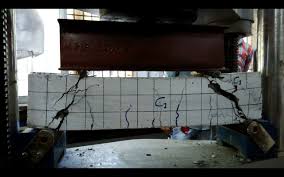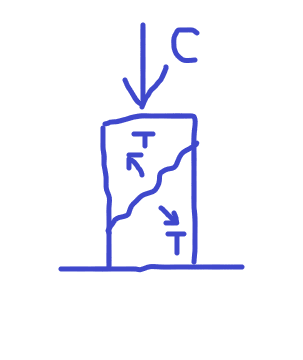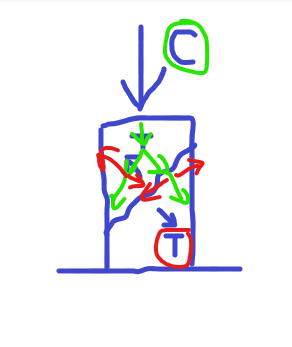Navigation
Install the app
How to install the app on iOS
Follow along with the video below to see how to install our site as a web app on your home screen.
Note: This feature may not be available in some browsers.
More options
Style variation
-
Congratulations MintJulep on being selected by the Eng-Tips community for having the most helpful posts in the forums last week. Way to Go!
You are using an out of date browser. It may not display this or other websites correctly.
You should upgrade or use an alternative browser.
You should upgrade or use an alternative browser.
RC Wall Under Strength for Shear
- Thread starter Ericson66
- Start date
- Status
- Not open for further replies.
Rod,
There are several methods to calculate Ko, I happened to like the simple method, Ko = 1-sin∅. For granular backfill, the usual internal friction angle ranges from 27° to 33°, and the range of the resulting Ko is 0.45 - 0.55. I've spent a lot of time on hydroelectric project, in which 0.5 was the norm for the preliminary design. Please note that Ko can go much higher should compaction is to be considered. (Usual range of Ko, loose sand 0.4, dense sand 0.6, with tamping 0.8)
There are several methods to calculate Ko, I happened to like the simple method, Ko = 1-sin∅. For granular backfill, the usual internal friction angle ranges from 27° to 33°, and the range of the resulting Ko is 0.45 - 0.55. I've spent a lot of time on hydroelectric project, in which 0.5 was the norm for the preliminary design. Please note that Ko can go much higher should compaction is to be considered. (Usual range of Ko, loose sand 0.4, dense sand 0.6, with tamping 0.8)
BridgeSmith
Structural
retired13's last response got me thinking...Ericson66, have you considered using reinforced backfill (mechanically stabilized earth) to reduce the soil pressure on the wall?
Rod Smith, P.E., The artist formerly known as HotRod10
Rod Smith, P.E., The artist formerly known as HotRod10
I agree with phamENG. I would make very sure that you analyzed this appropriately before you make a claim that it is deficient. What does your code allow in terms of decreasing the angle of inclination of diagonal compressive stresses and increasing the factor controlling the ability of diagonally cracked concrete to transmit tension and shear? Traditionally, these may be taken as 45 degrees and 2.0 but perhaps can be optimized if there is low steel strain.
I was thinking you could drill holes through the wall and pressure inject a chemical grout into the surrounding soil but this typically requires cohesionless soil with little to no fines. It would be nice if some of the geotechs could offer their opinion on this matter.
I was thinking you could drill holes through the wall and pressure inject a chemical grout into the surrounding soil but this typically requires cohesionless soil with little to no fines. It would be nice if some of the geotechs could offer their opinion on this matter.
I think BridgeSmth might be on to something.
OP states only 5m of wall has been built.
MSE or grout injection might be possible.
That might "solve" the problem but it doesn't answer the question of how to improve shear capacity. For that, I assume shear friction would be helpful approach.
OP states only 5m of wall has been built.
MSE or grout injection might be possible.
That might "solve" the problem but it doesn't answer the question of how to improve shear capacity. For that, I assume shear friction would be helpful approach.
JoelTXCive
Civil/Environmental
I'm liking Bridgesmith's thinking. Could you drill holes and do soil nails, or other tie-backs to lessen the load?
BridgeSmith
Structural
Darn those metric dimensions! I was envisioning 5ft, not 5m, built, and assuming that it had not yet been backfilled. If it has, then some sort of soil-mixing or grout injection might be preferable to re-excavating to put in geogrid.
Rod Smith, P.E., The artist formerly known as HotRod10
Rod Smith, P.E., The artist formerly known as HotRod10
Erikson66 said:Any one with experience with this product as a solution to shear problem Shear design of externally bonded FRP systems??
Not sure how you would do this on a flat wall. This is intended for beams where you can wrap it completely around, or at least on 3 sides. If you were thinking of that route, I would rather drill and epoxy U bar stirrups into the wall. However, I think there have been much better suggestions thrown out there so far.
It it hasn't been backfilled yet, why don't you backfill it (or a portion of it) with CLSM?
Correct me if I'm wrong but I'm guessing the whole thing is cofferdammed outside of the perimeter of the raft slab. Which only leaves about 4.5ft of width to backfill. MSE wouldn't be very effective in such a thin strip.
Correct me if I'm wrong but I'm guessing the whole thing is cofferdammed outside of the perimeter of the raft slab. Which only leaves about 4.5ft of width to backfill. MSE wouldn't be very effective in such a thin strip.
JoelTXCive
Civil/Environmental
Correct me if i'm wrong but I thought FRP would only help you with in-plane shear in a wall. I didn't think it could do anything for out of plane shear forces?
- Thread starter
- #34
For a rudimentary physical description:
Diagonal shear - the compression will effectively "close" the cracking caused by shear and thereby increase the shear capacity.
Shear Friction - the compression will add to the normal force, increasing the friction occurring on the subject plane and increasing the shear capacity.
How these physical phenomenon are applied to design depends on the code you're using. I think you're in Australia - I'm afraid I'm not familiar with your specific design code requirements so some other folks will have to help you with that.
Diagonal shear - the compression will effectively "close" the cracking caused by shear and thereby increase the shear capacity.
Shear Friction - the compression will add to the normal force, increasing the friction occurring on the subject plane and increasing the shear capacity.
How these physical phenomenon are applied to design depends on the code you're using. I think you're in Australia - I'm afraid I'm not familiar with your specific design code requirements so some other folks will have to help you with that.
The shear crack will propagate then leads to crumbling of the specimen. The point here is compression causes shear to occur, or depress shear force. I would agree that the compressive tends to close a gap AFTER a gap is formed, similar to the effect of post-tensioning.
- Status
- Not open for further replies.
Similar threads
- Replies
- 2
- Views
- 654
- Replies
- 7
- Views
- 14K
- Replies
- 0
- Views
- 2K
- Replies
- 3
- Views
- 3K
- Question
- Replies
- 7
- Views
- 1K



